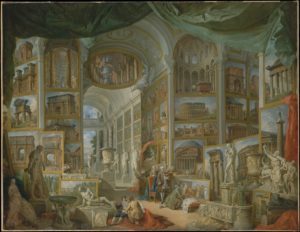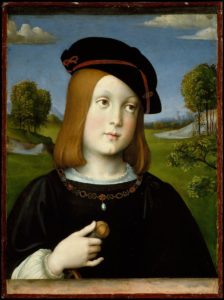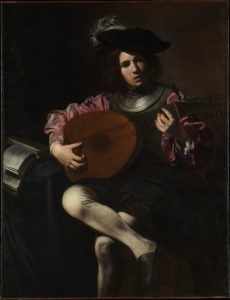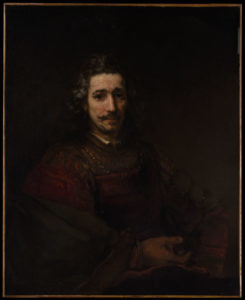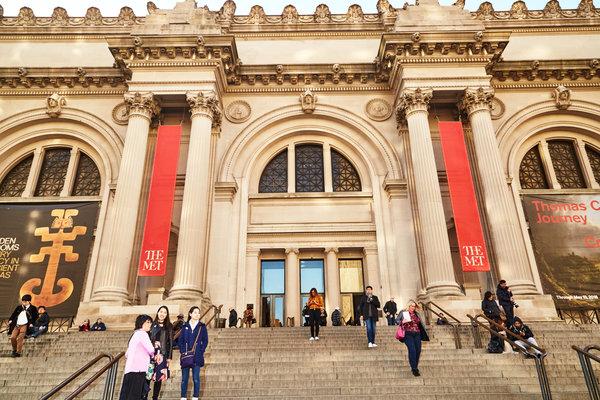Ariel A. Benzur
Professor Shaw
Art 1010
December 7th, 2018
Renaissance & Baroque Ideology: A Tour at The Met Fifth Avenue
After the fall of the Byzantine Empire, Italy learned of cultures outside of its country. This led to what’s known as the Renaissance & Baroque periods & Baroque periods. The Renaissance & Baroque periods & Baroque periods went through the fourteenth through eighteenth centuries that focused on the idea of humanism. However, humanism in the Renaissance & Baroque periods were different compared to Ancient Greek Humanism. Including the belief that humans should be focused more on themselves instead of gods, the Renaissance & Baroque periods created the belief that we had the potential to become excellent though studying. The Renaissance & Baroque periods changed the world in many ways. Furthermore, one of the most prominent changes in modern art is the art of the Renaissance & Baroque periods.
The first painting, Ancient Rome by Giovanni Paolo Panini painted in 1757 which can be seen in Gallery 629, shows us what Rome was. The painting depicts famous pieces of art created in the times of Ancient Rome, some of these pieces include famous Italian landmarks, Trajan’s column, the Farnese Hercules, and the Laocoön. The color and tone of the painting is bright as well as its linear design gives everyone a better view of Rome’s beautiful art history. This painting changed the world by showing everyone the true beauty of Ancient Roman art but at the same time using “modern” techniques.
The second painting, Federico Gonzaga by Francesco Francia painted in 1510 which can be seen at Gallery 643, exemplifies what the Renaissance & Baroque periods changed. The painting is a portrait of a boy named Federico who was ten at the time of the painting. The color is bright for the background however the child is wearing a dark outfit. The linear pattern along this painting is 2D but in some angles looks as if it were 3D. It is a normal sized portrait size at 19×14 inches. What makes this painting so great is how different the style is against the older times as it is more intricate and detailed versus a painted from the Renaissance & Baroque periods.
The third painting, Lute Player by Valentin de Boulogne painted in 1625 & 1626 which can be seen at Gallery 634, shows the integration of other cultures into Italian culture. The painted depict a lute player playing his lute. The painting is in dark colors with an entirely black background. The lines on this picture is linear which is a commonality in all Renaissance art. The use of oil painting in this piece allowed Boulogne gave him the ability to place more delicate features on the player’s face & body. Boulogne who was a French painter followed famous Italian artist Caravaggio, which allowed Boulogne to bring new art ideas into Roman art.
The fourth painting, Man with a Magnifying Glass by Rembrandt painted in the early 1660’s which can be seen at Gallery 964, shows the idea of humanism being integrated into Roman culture. The painting depicts an Amsterdam auctioneer who sold off one of Raphael’s pieces. The color is ominous giving the tone of the piece a darker feel. This may be due to the auctioneer’s old age which can be seen due to the use of oil painting. Rembrandt used oil painting to provide intricate details like wrinkles. The use of a regular person as the main feature instead of a god-like human or an actual god in the piece shows off what the Romans have learnt through the Renaissance & Baroque periods.
The fifth painting, Curiosity by Gerard ter Borch the Younger painted in the early 1660’s which can be seen at Gallery 964. This painting depicts three women writing a letter, which is very odd due to the fact that most people weren’t literate and in turn couldn’t write. The color and tone of the picture is dark with only the women’s dresses painted with light colors. Dutch women who were rich were able to read and write because of the way the Dutch were raised. Unlike the Dutch, European countries wanted women to only do housework and not to learn anything else. The furniture in the background gives the picture a Renaissance & Baroque feel due to it being modern-like.
This museum tour which you can go on in The Met on Fifth Avenue exemplifies the Renaissance & Baroque periods showing the past Roman art via Ancient Rome and the present through the other four pictures. Showing off the art of the Renaissance & Baroque periods is important because many current paintings are inspired through painting done in the Renaissance & Baroque periods and without the Renaissance happening, art in this world would look completely different and less intricate unlike what we have today.
